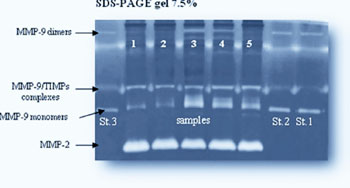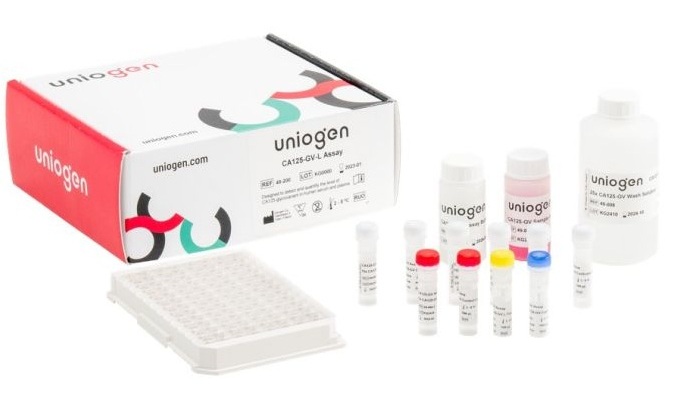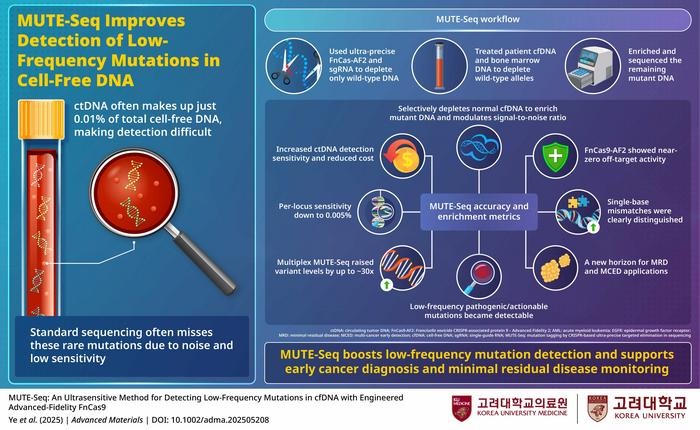Quantitative Gel Zymography Reappraised for Matrix Metalloproteinases
|
By LabMedica International staff writers Posted on 29 Oct 2014 |

Image: The gel zymography separation of matrix metalloproteinases (MMPs) on a 7.5% polyacrylamide gel (Photo courtesy of the Italian National Research Council).
A reappraisal of quantitative gel zymography technique for matrix metalloproteinases (MMPs) in human plasma has been used for comparison with commercially available enzyme-linked immunosorbent assay (ELISA).
The determination of MMPs is relevant in numerous pathophysiological conditions, as imbalanced MMP activity is associated with many clinical conditions, including cardiovascular diseases, especially if associated with extracellular matrix remodeling, but the results obtained are closely linked to the method used and are not directly comparable.
Scientists at the Italian National Research Council (CNR; Pisa, Italy) obtained heparinized blood samples from 25 volunteers. The samples were centrifuged and the serum stored in aliquots at −80 °C. Gel zymography was performed based on sodium dodecyl sulfate-polyacrylamide gel electrophoresis (SDS-PAGE) and on the use of gelatin 0.5% as substrate for detection of MMP enzymatic activity. Gelatinolytic activities were detected as unstained bands against the background of Coomassie Blue stained gelatin. In order to quantify the concentrations of the analyzed protein in the unknown samples, a dose-response curve was built in each run.
Total MMP-9 was measured in diluted plasma by specific immunometric assay (R&D Systems; Minneapolis, MN, USA), previously standardized. The working range was 0.19 ng/mL to 16 ng/mL, the sensitivity was 0.05 ± 0.01 ng/mL, and the within-assay variability was 414.3 ± 23.5 ng/mL (5.7%), while the between-assay variability was less than 15%. The concentration of total MMP-9 was measured in parallel using the zymography and ELISA for comparison purposes.
The results obtained by gel zymography analysis of human blood samples using different acrylamide/bis acrylamide ratios indicated that 7.5% gels are the more suitable for visualizing MMP-9 forms. In all conditions, four bands with gelatinolytic activity are found: MMP-9 dimers, MMP-9– tissue inhibitor of metalloproteinase1 (TIMP-1) complex, MMP-9, and MMP-2. The time course of the proteolytic activity of MMPs indicated 16 to 24 hours as optimal incubation time and these optimal parameters were used for routine assay. A linear positive correlation was found between the MMP-9 values of zymography and ELISA with the ELISA values significantly lower than those obtained with zymography.
The authors concluded that the main advantage of gel zymography is that it allows visualization of both the latent and active forms of gelatinases. The presence of MMP dimers and MMP/TIMP complexes in the plasma samples, revealed by gel zymography, could thoroughly characterize the role of MMP in associated diseases. Gel zymography allows separation and visualization of MMP-2 bands, so both MMP-2 and MMP-9 can be determined in the same run from a single biological sample. The study was published in the September 2014 issue of the Journal of Clinical Laboratory Analysis.
Related Links:
Italian National Research Council
R&D Systems
The determination of MMPs is relevant in numerous pathophysiological conditions, as imbalanced MMP activity is associated with many clinical conditions, including cardiovascular diseases, especially if associated with extracellular matrix remodeling, but the results obtained are closely linked to the method used and are not directly comparable.
Scientists at the Italian National Research Council (CNR; Pisa, Italy) obtained heparinized blood samples from 25 volunteers. The samples were centrifuged and the serum stored in aliquots at −80 °C. Gel zymography was performed based on sodium dodecyl sulfate-polyacrylamide gel electrophoresis (SDS-PAGE) and on the use of gelatin 0.5% as substrate for detection of MMP enzymatic activity. Gelatinolytic activities were detected as unstained bands against the background of Coomassie Blue stained gelatin. In order to quantify the concentrations of the analyzed protein in the unknown samples, a dose-response curve was built in each run.
Total MMP-9 was measured in diluted plasma by specific immunometric assay (R&D Systems; Minneapolis, MN, USA), previously standardized. The working range was 0.19 ng/mL to 16 ng/mL, the sensitivity was 0.05 ± 0.01 ng/mL, and the within-assay variability was 414.3 ± 23.5 ng/mL (5.7%), while the between-assay variability was less than 15%. The concentration of total MMP-9 was measured in parallel using the zymography and ELISA for comparison purposes.
The results obtained by gel zymography analysis of human blood samples using different acrylamide/bis acrylamide ratios indicated that 7.5% gels are the more suitable for visualizing MMP-9 forms. In all conditions, four bands with gelatinolytic activity are found: MMP-9 dimers, MMP-9– tissue inhibitor of metalloproteinase1 (TIMP-1) complex, MMP-9, and MMP-2. The time course of the proteolytic activity of MMPs indicated 16 to 24 hours as optimal incubation time and these optimal parameters were used for routine assay. A linear positive correlation was found between the MMP-9 values of zymography and ELISA with the ELISA values significantly lower than those obtained with zymography.
The authors concluded that the main advantage of gel zymography is that it allows visualization of both the latent and active forms of gelatinases. The presence of MMP dimers and MMP/TIMP complexes in the plasma samples, revealed by gel zymography, could thoroughly characterize the role of MMP in associated diseases. Gel zymography allows separation and visualization of MMP-2 bands, so both MMP-2 and MMP-9 can be determined in the same run from a single biological sample. The study was published in the September 2014 issue of the Journal of Clinical Laboratory Analysis.
Related Links:
Italian National Research Council
R&D Systems
Latest Clinical Chem. News
- Online Tool Detects Drug Exposure Directly from Patient Samples
- Chemical Imaging Probe Could Track and Treat Prostate Cancer
- Mismatch Between Two Common Kidney Function Tests Indicates Serious Health Problems
- VOCs Show Promise for Early Multi-Cancer Detection
- Portable Raman Spectroscopy Offers Cost-Effective Kidney Disease Diagnosis at POC
- Gold Nanoparticles to Improve Accuracy of Ovarian Cancer Diagnosis
- Simultaneous Cell Isolation Technology Improves Cancer Diagnostic Accuracy
- Simple Non-Invasive Hair-Based Test Could Speed ALS Diagnosis
- Paper Strip Saliva Test Detects Elevated Uric Acid Levels Without Blood Draws
- Prostate Cancer Markers Based on Chemical Make-Up of Calcifications to Speed Up Detection
- Breath Test Could Help Detect Blood Cancers
- ML-Powered Gas Sensors to Detect Pathogens and AMR at POC
- Saliva-Based Cancer Detection Technology Eliminates Need for Complex Sample Preparation
- Skin Swabs Could Detect Parkinson’s Years Before Symptoms Appear
- New Clinical Chemistry Analyzer Designed to Meet Growing Demands of Modern Labs

- New Reference Measurement Procedure Standardizes Nucleic Acid Amplification Test Results
Channels
Molecular Diagnostics
view channel
Ovarian Cancer Assay Outperforms Traditional Tests in Early Disease Detection
Globally, ovarian cancer is one of the deadliest cancers affecting women. Traditionally, early diagnosis of ovarian cancer has been challenging. Many ovarian cancers are diagnosed only after they have... Read more
Ultrasensitive Method Detects Low-Frequency Cancer Mutations
Liquid biopsy has emerged as a promising approach for cancer detection and treatment monitoring, although its clinical impact has been limited by the extremely low levels of tumor-derived DNA circulating in blood.... Read moreHematology
view channel
MRD Tests Could Predict Survival in Leukemia Patients
Acute myeloid leukemia is an aggressive blood cancer that disrupts normal blood cell production and often relapses even after intensive treatment. Clinicians currently lack early, reliable markers to predict... Read more
Platelet Activity Blood Test in Middle Age Could Identify Early Alzheimer’s Risk
Early detection of Alzheimer’s disease remains one of the biggest unmet needs in neurology, particularly because the biological changes underlying the disorder begin decades before memory symptoms appear.... Read more
Microvesicles Measurement Could Detect Vascular Injury in Sickle Cell Disease Patients
Assessing disease severity in sickle cell disease (SCD) remains challenging, especially when trying to predict hemolysis, vascular injury, and risk of complications such as vaso-occlusive crises.... Read more
ADLM’s New Coagulation Testing Guidance to Improve Care for Patients on Blood Thinners
Direct oral anticoagulants (DOACs) are one of the most common types of blood thinners. Patients take them to prevent a host of complications that could arise from blood clotting, including stroke, deep... Read moreImmunology
view channel
Routine Blood Test Can Predict Who Benefits Most from CAR T-Cell Therapy
CAR T-cell therapy has transformed treatment for patients with relapsed or treatment-resistant non-Hodgkin lymphoma, but many patients eventually relapse despite an initial response. Clinicians currently... Read more
New Test Distinguishes Vaccine-Induced False Positives from Active HIV Infection
Since HIV was identified in 1983, more than 91 million people have contracted the virus, and over 44 million have died from related causes. Today, nearly 40 million individuals worldwide live with HIV-1,... Read more
Gene Signature Test Predicts Response to Key Breast Cancer Treatment
DK4/6 inhibitors paired with hormone therapy have become a cornerstone treatment for advanced HR+/HER2– breast cancer, slowing tumor growth by blocking key proteins that drive cell division.... Read more
Chip Captures Cancer Cells from Blood to Help Select Right Breast Cancer Treatment
Ductal carcinoma in situ (DCIS) accounts for about a quarter of all breast cancer cases and generally carries a good prognosis. This non-invasive form of the disease may or may not become life-threatening.... Read moreMicrobiology
view channel
Blood-Based Diagnostic Method Could Identify Pediatric LRTIs
Lower-respiratory tract infections (LRTIs) are a leading cause of illness and death worldwide, and pneumonia is the leading infectious cause of death in children under five, claiming the lives of over... Read more
Rapid Diagnostic Test Matches Gold Standard for Sepsis Detection
Sepsis kills 11 million people worldwide every year and generates massive healthcare costs. In the USA and Europe alone, sepsis accounts for USD 100 billion in annual hospitalization expenses.... Read moreRapid POC Tuberculosis Test Provides Results Within 15 Minutes
Tuberculosis remains one of the world’s deadliest infectious diseases, and reducing new cases depends on identifying individuals with latent infection before it progresses. Current diagnostic tools often... Read more
Rapid Assay Identifies Bloodstream Infection Pathogens Directly from Patient Samples
Bloodstream infections in sepsis progress quickly and demand rapid, precise diagnosis. Current blood-culture methods often take one to five days to identify the pathogen, leaving clinicians to treat blindly... Read morePathology
view channel
Rapid Low-Cost Tests Can Prevent Child Deaths from Contaminated Medicinal Syrups
Medicinal syrups contaminated with toxic chemicals have caused the deaths of hundreds of children worldwide, exposing a critical gap in how these products are tested before reaching patients.... Read more
Tumor Signals in Saliva and Blood Enable Non-Invasive Monitoring of Head and Neck Cancer
Head and neck cancers are among the most aggressive malignancies worldwide, with nearly 900,000 new cases diagnosed each year. Monitoring these cancers for recurrence or relapse typically relies on tissue... Read more
Common Health Issues Can Influence New Blood Tests for Alzheimer’s Disease
Blood-based tests for Alzheimer’s disease are transforming diagnosis by offering a simpler alternative to spinal taps and brain imaging. However, many people evaluated at memory clinics also live with... Read more
Blood Test Formula Identifies Chronic Liver Disease Patients with Higher Cancer Risk
Chronic liver disease affects millions worldwide and can progress silently to hepatocellular carcinoma (HCC), one of the deadliest cancers globally. While surveillance guidelines exist for patients with... Read moreTechnology
view channel
Machine Learning Models Diagnose ALS Earlier Through Blood Biomarkers
Amyotrophic lateral sclerosis (ALS) is a rapidly progressive neurodegenerative disease that is notoriously difficult to diagnose in its early stages. Early symptoms often overlap with other neurological... Read more
Artificial Intelligence Model Could Accelerate Rare Disease Diagnosis
Identifying which genetic variants actually cause disease remains one of the biggest challenges in genomic medicine. Each person carries tens of thousands of DNA changes, yet only a few meaningfully alter... Read moreIndustry
view channel
Abbott Acquires Cancer-Screening Company Exact Sciences
Abbott (Abbott Park, IL, USA) has entered into a definitive agreement to acquire Exact Sciences (Madison, WI, USA), enabling it to enter and lead in fast-growing cancer diagnostics segments.... Read more

















